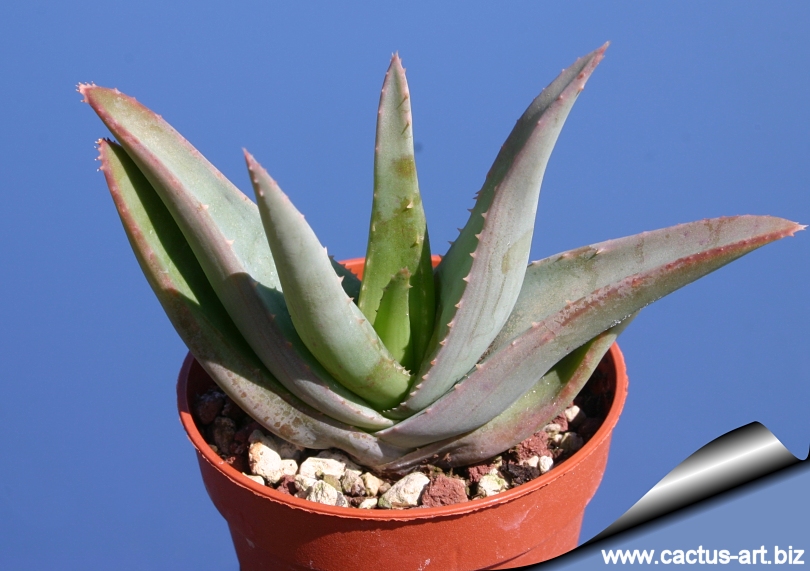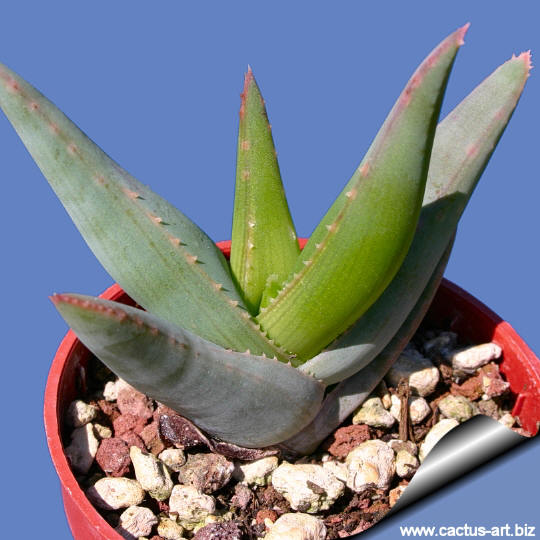|
|
|

Aloe longistyla (A
young specimen in late winter)
Nice smaller turquoise-blue plant that only get about 20 cm tall
and makes a great potted Aloe.
Aloe krapohliana can take a few degrees of frost in winter, but prefer
hot summers.
|
|
Description: Nice smaller
turquoise-blue rosette-forming plant that only get about 20-35 cm tall
with large flowers. Generally solitary it can sometime makes offshoots
forming a small group. (The var. dumoulinii is clumping) It has an open
upright habit but in time of drought it tends to curl in on itself.
Stem: Stemless
Leaves: In a spiralled rosette in old plants, but in very young
plants they are ranked in vertical rows. Short, thick, fusiform, neither
tuberculate nor prickly that tapers off to nearly a circular shape at
the tips, blue-green with often with darker or whiter bands (in winter
and under stress condition it can show nice pink hues).
Flowers: Relatively short but thick & large in relation to this
small aloe plant, on racemes only 20 -30 cm tall simple bright orange/
red flowers, rarely if ever branched.
Blooming season: Winter.
|
|
 |
 |
|
Leaves are
turquoise-blue,
unspotted and form a spiralled rosette at the stem apex in old plants,
but in juvenile plants they are ranked in vertical rows.
|
|


Advertising
|
|
|
| |
|
|
Family: Asphodelaceae
Scientific name:
Aloe krapohliana Marloth
In: Trans. Roy. Soc. South Africa 1:408. 1910
Common Names include: Karoo Aloe,
Ramenas, Aloe
Origin: South Africa (northwestern corner of the Cape Province),
Namibia
Habitat: This
aloe grows in the winter rainfall area where it take some light frost.
Summers are hot and arid and the rainfall in winter is very low, they
are usually found under bushes plant in shade.
Etymology: Named for H.C. Krapohl, the original collector.
|
|
|
|

Cultivation: Aloe krapohliana
can withstand frost (can take a few degrees of frost in winter), but
prefer hot summers. The real killer of this pretty aloe is water. Give
them a dry time to rest - Never water them on a hot day. Native to the
winter rainfall areas of South Africa, so don’t water on a hot day! It’s
the easiest way to kill this aloe. Easy to grow, requiring very little
care. It can be grown in small containers. Always use a good quality,
loamy sandy soil with plenty of drainage chips at the bottom of
containers. It tolerates weekly watering in the summer; once a month, or
not at all in the colder months of December and January. Can withstand
long periods of drought, but they will thrive and flower more profusely
if watered in the correct season. Incorrect watering, poor drainage or
too much shade can lead to attack by pests and diseases. It grows
much better outdoors in spring and summer.
In mild climates it can be cultivated outdoors for use in landscaping,
preferably planting it in hot and dry rock gardens. They will grow best
in regions with a climate close to that of their native deserts
not too cold, and not too wet.
Propagation: Almost
exclusively by seeds planted in autumn, in trays of coarse river sand.
Uses:
- Gardening: Well suited to a rock garden,
on a sloping bank or even in containers. Plant in bold clumps. It is a
very rewarding plant, especially in winter when the flowers add a
fiery glow to an otherwise drab garden.
|
|